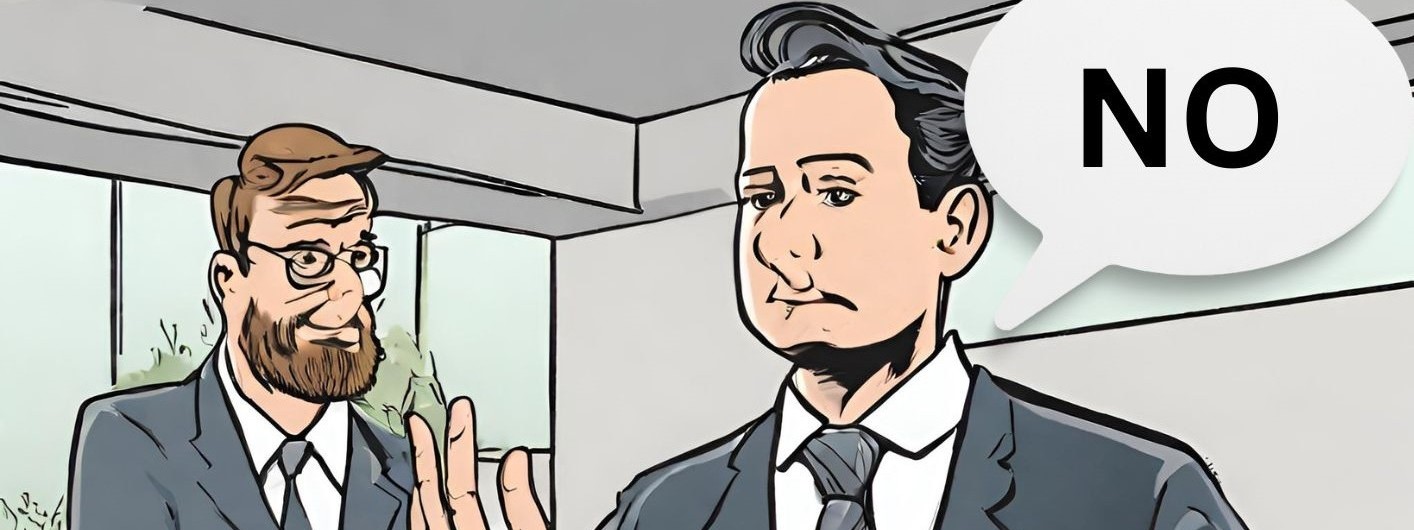OBJECTIONS
Posted on 29th January 2024 at 07:16
In sales there are times when you just cannot close the deal.
You rock along presenting, thinking you’re onto a winner.
Then it happens. Objections rear their ugly heads and you come to a complete stop.
After all – we’re told the customer is always right and you just don’t want to be pushy.
Damn it!!
A lot of the new guys coming into sales have never had to deal with face-to-face sales presentations. They’re just not trained to handle objections correctly.
You know what it’s like, you and your sales teams spend an inordinate amount of time pitching and presenting to prospects, for what?
“I’ll think about it”,
“Can you email me those details?”
or the worst, “We never decide on the day”
What a waste of time presenting
A waste of advertising spend
A waste of salary
AND most importantly (because you could’ve been in a selling appointment) time.
Well, how do you overcome these objections?
What if I told you, you can remove the most common objections before they become objections?
Cool huh?
In no particular order I have prepared a guide to handle to most popular excuses not to buy, erm – sorry I mean objections.
7 ways to overcome objections.
1. Listen, Question, Repeat, Think, Handle
Whatever the objection we need to make sure we identify exactly why there is a hold up in the buying process.
A. Listen to exactly what is being said, stop talking, stop presenting and just listen to what the real objection is. Listening also buys us a bit of time to evaluate how we will handle the objection.
B. Question the prospect in an understanding, empathetic way. We don’t want to appear confrontational, but by asking questions you’re encouraging the prospects to explain their objection. It maybe they just understand one small thing you have just explained.
C. Repeat the objection, sometimes just saying out loud, exactly what the prospects have said to you, has the objection clarified. Let them understand what they have just said to you and ask if your right in thinking, that this is the objection.
D. Think about the solutions at your disposal. Never just blurt out the first thought that comes into your head. Think what will happen if you offer A, B or C solution.
E. Now that you fully understand the objection, we have isolated it and clarified it, we can handle it. Give the prospects your solution, explain the facts again and ask if that solves their dilemma.
2. Identify and isolate the objection. Make sure that is the only objection.
So we identify the objection as in step 1 above, but there’s more than one. Don’t panic, take a breath. We must isolate each objection. There may be more than one, but we can only deal with oner at a time. Spend time isolating and understanding each objection as I step 1 above.
3. Clarify the objection – make sure you understand EXACTLY what is being objectified.
Once you clarify each objection and you understand what and why it is an objection, you are in a much better position to overcome it. Again, if there are more than one objection, clarify the first and deal with it, then move on to the next.
4. Is it the price?
It is almost always the price. Unless you are skilled in price conditioning, the price of a product (at the end of a presentation) will always come as a shock to prospects. AND their knee jerk reaction is to say they cannot afford it. Your job now is to isolate that price is the ONLY objection. I can work with money – I can’t do anything with a lack of interest.
5. Always use the phrase “If I can, Will you?”
I loved this phrase, it was taught to me way back in my early days of being a field sales agent. Let’s imagine cost is the objection. We know we can reduce the price a little but to just offer a lower price will destroy any faith you have built with the prospects. Identify, clarify etc and then ask, “So is it just the cost you are objecting to?” They say ‘Yes’
Now you say “If I can reduce the price, Will you be placing an order?” Or “If I can offer a better deal, Will you be able to say yes today?” Words to that effect.
However, never ever just drop the price to try and cement a deal, you MUST offer a justifiable discount. I always offer a discount if I can use the before and after photos (cheaper than running ads right?), or a testimonial. Whatever you chose to do – it must be believable.
6. Lack of urgency “We don’t need it/them yet”
Sadly this is something the sales agent needed to address in his/her presentation. The prospects may love the products, really want to buy it/them but just not at this time. Trouble is, if you don’t close this now, they will look elsewhere and all your hard work will drive them into your competitor’s business. Never the less – we need to deal with it now. You can overcome this by offering to ‘hold’ the price and deliver at a more convenient time, but I need a small deposit today. By placing a deposit today, you will also bypass the impending price rise we have coming soon.
7. Re-phrase.
By re-phrasing the objection and repeating it to your prospects, sometimes it can trivialise their objection and make it seem such a small thing they got hung up on. I once had a client didn’t want to place an order because I don’t deal with scaffolders and they didn’t know a scaffolder. So, I asked them if that was the only objection – they said yes. I took out my phone and Google’d local scaffolders and got a quote there and then. The objection dissolved as quickly as it came up and I got the order.
8. Testimony
One great way to solve an objection issue to use testimonials of other satisfied customers. I keep a presentation folder and have lots and lots of testimonials which deals with just about every objection you can imagine. Social proofing is a great way to get other prospects on side. If Mary isn’t sure what white walls will look like on her home, I have lots of photo’s of other houses and how they looked prior to the work being done.
9. Feel, felt, found
This is one of the best ways to handle objections I have ever heard and used. Whatever the objection you need to see it from the prospects point of view and say, “I know how you feel, (understanding, empathy, taking their side) I felt the same way when I first looked at this.” At this point they relax a bit, knowing they’re not the only ones with this objection. Then you need to say, “What I found was, when I went ahead etc etc etc…..”
Then I always say – “does that make sense?”
So this little cheat sheet may help you with any objection you may get in the future.
Try them, let me know how you get on – happy to help if you have any persistent objections that keep re-occurring.
Having said all of that – I very rarely get objections. Do you want to know how?
Natural Born Salesman
I believe NOT!
Selling is sometimes looked upon as a dark art, something that other people are good at or it is hoped marketing will bring in more sales. Most business owners I know are great at what they do - but lack the ability to 'sell' themselves, their business or products. They believe someone like me is a natural born salesman. ‘Not true’ I tell them, I was a shy kid and scared of my own shadow - so what changed. My mindset AND the need to earn money quickly.
Not one good salesman I know or have worked alongside was born a good sales person. Over their lives they have developed skills to aid them in selling. Skills such rapport building, self-confidence and resilience. They needed a grounding in basic selling skills but other than that, it’s all about the desire to succeed. Anyone can sell - we have all sold something. Everyone married has given at least one great sales pitch that someone has bought!
One thing we must have to sell effectively is passion. Enthusiasm will give you in spades what you lack in ability. I have never sold anything I didn't believe in passionately. When you speak about your products, the prospect must be able to pick up on your passion and enthusiasm. Once you feel this passion -- your halfway there. The next step is influencing the prospect into believing you are the answer to their prayers. Selling AND influencing will bring you so much more business, win more clients and get those referrals coming in.
Read more in my new book – ‘How to convert a HOT prospect’
Appointment Setting
So the advert and the prospecting has begun to bring in results – we’re getting phone calls or emails suggesting the person is interested in our offering.
Most businesses are going to be shooting out of the gates and making a bee line for the prospect’s money by getting a sales person on their couch. 'BUT WAIT' I say.
Let’s begin with the initial appointment setting process - don't just hurry to get a salesman sat in front of the client. That could be a real waste of time and manpower. I will rule them out in a heartbeat to save my time. I ensure at this stage the prospect wants my stuff and not just some cheap crud my competitors are flogging. Ask pertinent questions to see if 'we' really want 'them' to take up valuable time when they have no real urgency to buy from us. Yes - you might find that the client doesn't really want to buy anything - they're just satisfying an urge to find out if they can afford a product. They might be looking to re mortgage next year and add something to the budget. In this case, even the best salesman you have won't/can't close the deal.
Once we find a need for the product/service we offer we need to ascertain a time frame.
Ask whether they have other quotes in the pipeline (I don't relish being first across the door, so I set my appointment AFTER they have collected a few quotes)
Ask about their timeline - when do they want it fitted/delivered.
I also ask if they want the best or the cheapest!! If they answer ‘cheapest’ I’ll probably not bother going. If they say ‘we want the best, but not sure what that is or what it costs etc’ – I’m going - to educate them.
Once I have all the information and have tried to rule the prospect out, only then will I decide to sit the appointment.
In this telephone questioning phase - that is when the real influencing begins. I find if you mention just a couple choice phrases (throw away lines - like, ‘we are running possible discounts to one home in that area’) you will be amazed at how much they will push to be the 'discounted' customer. Pretty much closing themselves.
In short – I decide if I want to sit an appointment, after all – it’s my time I’ll be investing. I also make it fit with my schedule not the prospects. I will give the prospect an illusion they have a say by asking ‘I’m available Monday or Tuesday, does Monday work for you?’ I will then say ‘I can be with you for 10 or 11am – which is best?’ I then fill up both days with other appointments (who have also ruled themselves in) to maximise my round trip. In two days I might sit 4 or 5 apps having conditioned them over the phone. I went to one last week having said it’ll be about £4500 in my price conditioning, I actually sold at £5000 after a discounted rate. It was mostly sold in my appointment setting phase.
Read more in my new book – ‘How to convert a HOT prospect’
Share this post:





